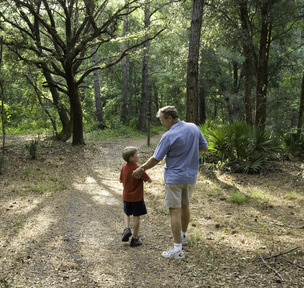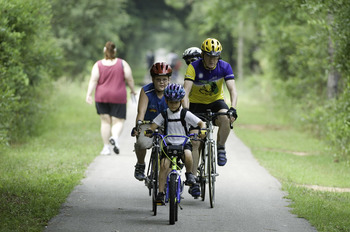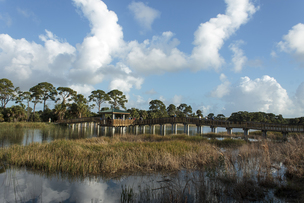|
Spring 2015
 Hiking in the Cross Florida Greenway, by John Moran
Governor
Rick Scott and the Florida Cabinet approved the purchase of a 194-acre addition to
the Cross Florida Greenway (Greenway) on March 24, This is the first from
a recent Office of Greenways and Trails (OGT) acquisition cycle. Located in Marion County between the Greenway and Ocala National Forest, the tract largely consists of upland pinewoods and is considered highly scenic. The proposed 21-mile Ocklawaha River Corridor Trail will traverse the property, linking Silver Springs State Park to the lower Ocklawaha River region.
“This
acquisition provides a critical connector for the Cross Florida Greenway,
furthering recreational opportunities through additional trailhead access and
camping areas,” said DEP Secretary Jon Steverson.
The
Cross Florida Greenway is a key component of the Florida Greenways and Trails System Plan
Priority Trails Network, and is home to approximately 36 miles of the Florida
National Scenic Trail. The greenway stretches 110 miles across central Florida from the
Gulf of Mexico on the west coast to the St. Johns River near the east coast.
The corridor encompasses diverse natural habitats and traverses four counties
(Citrus, Levy, Marion and Putnam). With hiking, biking, equestrian and paddling trails, boat ramps, fishing spots, campgrounds, playground and picnic shelters, the Greenway offers visitors of all interests and ages a great place to enjoy Florida's natural treasures.
In fiscal year 2013-14, 927,008 people visited the Greenway, generating an estimated $74,341,241 in direct economic impact. Of
the 171 units of the Florida State Parks System, the Greenway is ranked the
third-highest unit in attendance and direct economic impact; only Honeymoon
Island and the Florida Keys Overseas Heritage Trail rank higher.
Marcin Mrowka finishing his 50-mile race
By Chris Rodatz, Race Director
Participants came from Canada, South Africa, Austria, Great
Britain, Alaska and 20 of the lower 48 States! Almost 150 runners toed the
starting line in Florahome on the Palatka-to-Lake Butler State Trail at 7 a.m.
on February 7 for the Iron
Horse Endurance Runs. Temperatures were in the high 30s at the
start and would reach the low 60s. A perfect day for a race! Almost half of the
race was run on the scenic Palatka-to-Lake Butler State Trail with its
overhanging trees and Spanish moss. Then, the course shifted to dirt trails and
forest service roads in the Etoniah Creek State Forest.
The 100 milers were led from the beginning by California’s
Oswaldo Lopez who, although battling cramps, managed a 15:58 finishing time to
get his first Iron Horse sterling silver buckle. The first female was Kristen Jarembeck from
Washington DC in 4th place with a time of 21:08. In addition to receiving
a belt buckle or medal, winners also received a shoe gift card from Altra, the
zero drop shoe Company, and a bottle of wine from the locally owned Tangled
Oaks winery.
An attractive feature of the Iron Horse course is that, due
to its benign nature, it is not only a fast course, but an excellent course for
the beginning Ultrarunner. The 50 mile race was won in 7:30 by Robert Millican
from St Simons Island, Georgia, a transplanted triathlete. Right on his heels
came the ever effervescent Daniele Cherniak in 7:37 in her 2nd Iron
Horse 50 win (Daniele will do anything to get out of frigid New York). The
100km was no contest between men and women this year. Bonnie Collins from Del
Ray Beach, Florida burned the men in 11:10. The first man was Randall Edwards from
North Carolina in 11:31.
One of the great features of Ultrarunning are the many
unique runners one would never have time to get to know in a short race. One of
those is Marcin Mrowka, a Polish runner from New York, who hitched a ride from
Brooklyn to Jacksonville. He then rode his bicycle from Jacksonville to St
Augustine, a 40-50 mile stretch, spent the night, and pedaled to Palatka
another 30 miles. On race morning, he rode his bike 15 miles to the starting
line in Florahome and ran the 50 miler, finishing in 7th place with
a time of 8:11. After resting about an hour, he left to start the return trek
to Brooklyn. A true Ultrarunner if there ever was one.
Credit is due our volunteers who make the races a success.
From the Navy JROTC cadets, who man the aid stations during the day, to Dave
Bokros from Florida Striders Running Club at night, with his world famous
seafood gumbo at aid station 2, to the Putnam County Blueways and Trails CSO who
manned aid station 3 at night. Iron Horse 2016 will
be February 6-7 in 2016, so mark your calendars!
 Riders on the Tallahassee-St. Marks State Trail, part of the planned Capital City to Seas Trail, by John Moran.
By Jon Sewell
The Capital
City to the Sea Trails (CC2ST) Master
Plan envisions a series of shared use paths that will connect various areas
from Capital Cascades Park in the City of Tallahassee all the way to the Gulf
Coast in Wakulla County. The trails are intended to provide better connectivity
and mobility for residents and visitors traveling throughout Leon and Wakulla
Counties. The entire proposed CC2ST network will be over 120 miles once the
full master plan is implemented. The master plan was created through data
collection, extensive public involvement, and agency coordination and
participation. The Capital City to the Sea Trails Master Plan was adopted by
the Capital
Region Transportation Planning Agency (CRTPA) in April 2014 with a unanimous vote by the board members!
The first project to be developed
from the master plan is the Coastal Trail which begins at C.R. 59 and terminates at
Surf Road in Wakulla County. This
project is approximately 24 miles in length and will connect two existing
trails, the Tallahassee - St. Marks Historic Railroad
State Trail and Ochlockonee Bay Trail. The Project Development and Environment
(PD&E) Study for the Coastal Trail was approved by the CRTPA Board in April
2014 and initiated in June 2014 with an expected completion in early summer
2015.
Based on the expected completion
date of the PD&E Study, the CRTPA Board approved the use of funds for the
remaining phases of the project, Design, and Construction. While the PD&E covers the entirety of the
Coastal Trail limits, the Design phase will approach the completion of the
section from the St. Marks Trail (eastern terminus of the design project) to US
319 (western terminus of the design project) at this point in time with further
efforts made to finish the project as funding becomes available. The Design phase is schedule to begin in
early FY 15/16 and be completed in late FY 16/17.
 Boardwalk at Winding Waters Natural Area in Southeast Florida's Palm Beach County
Palm Beach County Commissioner Priscilla A. Taylor,
along with federal, state, and local project partners, officially opened the
public-use facilities at Winding
Waters Natural Area on March 12. After the ribbon- cutting ceremony, staff
led visitors on a guided tour along the nature trail, sharing stories about the
incredible transformation of the site. After the walk, County Administrator Bob
Weisman joined staff and local paddling enthusiasts on a kayak tour of the created
wetland. While Winding Waters has been open to the public since December
2012, it wasn’t until early March that all the finishing touches were in place
and the site was declared officially open.
The
restoration work of the area took five years and included the removal of 150
acres of exotic trees, relocation of over 2,000 trees, excavation of the
145-acre wetland, backfilling one mile of canal, installation of water control
structures to divert and retain water on site, planting of over 150,000 native
plants, and the construction of public-use facilities.
The Winding Waters public-use facilities include
a parking lot, informational kiosk, accessible kayak launch and nature trail,
260-foot boardwalk with covered observation platform, three-mile kayak trail,
and over five miles of hiking trails with four shade shelters strategically
placed along the way. The facilities were partially paid for with a grant from
the Florida Department of Environmental Protection’s (DEP) Recreational Trails Program.
Rick Mercer, former director of DEP’s Office of Operations, said, “It is so
rewarding to see Palm Beach County residents and visitors alike enjoy Winding
Waters Natural Area, which was designated into the Florida Greenways and Trails
System, a program administered by the Office of Greenways and Trails, Division
of Recreation and Parks. The Recreational Trails Program is honored to be a
part of this partnership and congratulates Palm Beach County on the project.”
The East Coast Greenway Alliance has a new Florida website: http://flgreenway.org/.
Stay tuned for the Summer edition of Connections for an exciting article about WHEELS, a bike/walk/transit/trails event to be held in Miami in November.
The 2015 Recreational Trails Program (RTP) grant submission cycle will be open April 15 - 30.
National Trails Day is Saturday, June 6, and many events will be hosted by Florida State parks and the Florida Trails Association. Find out about these events and more through the online OGT Community Calendar.
Cross Florida Greenway Manager Mickey Thomason was selected as the Florida Bicycle Association Trail Manager of the Year. Congratulations Mickey!
|